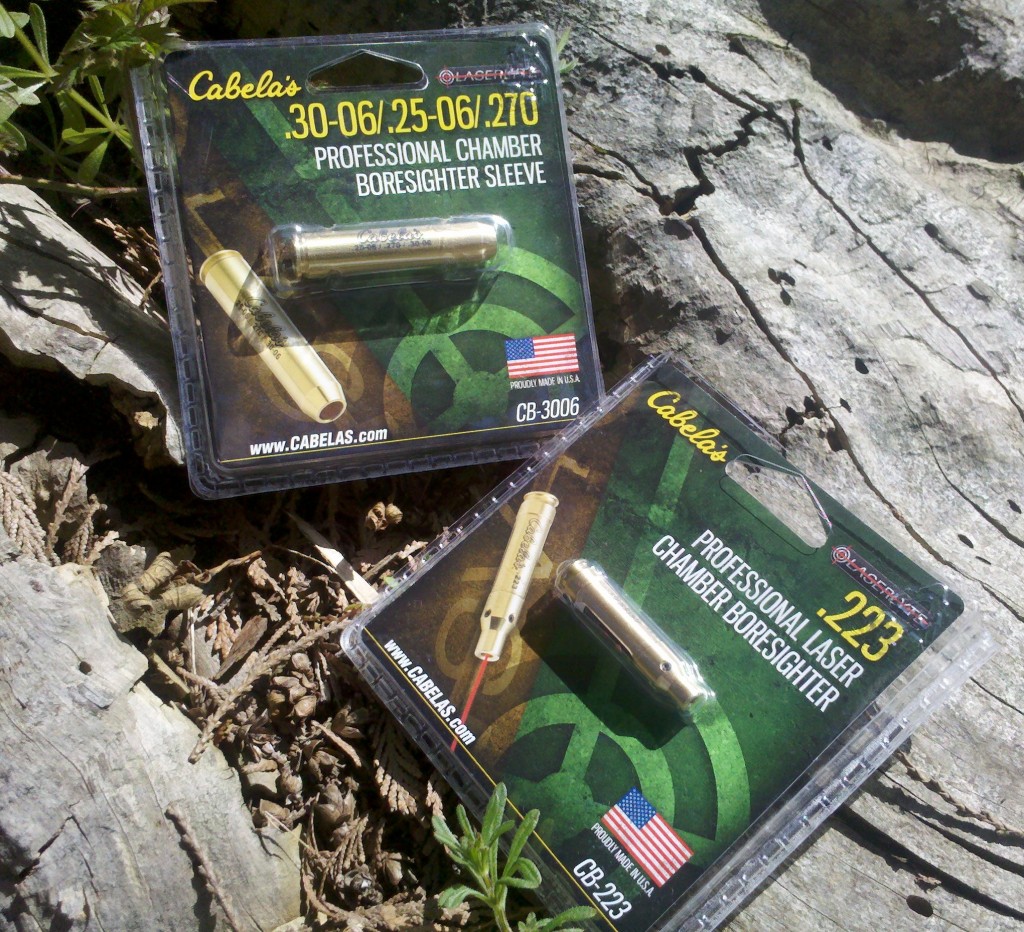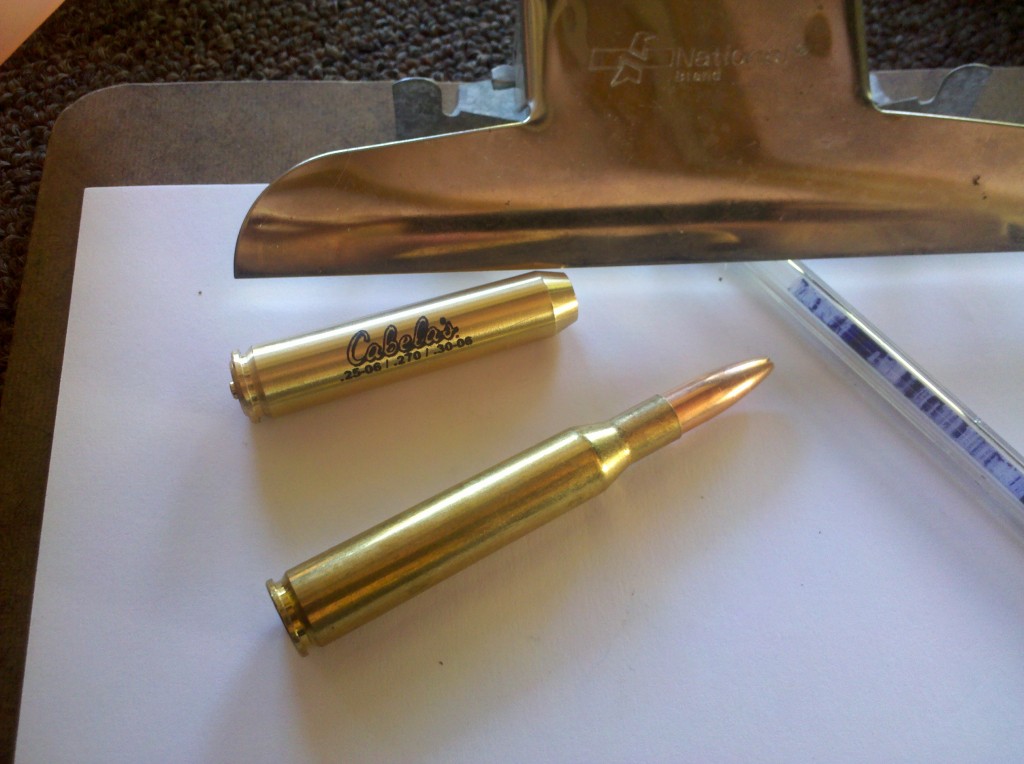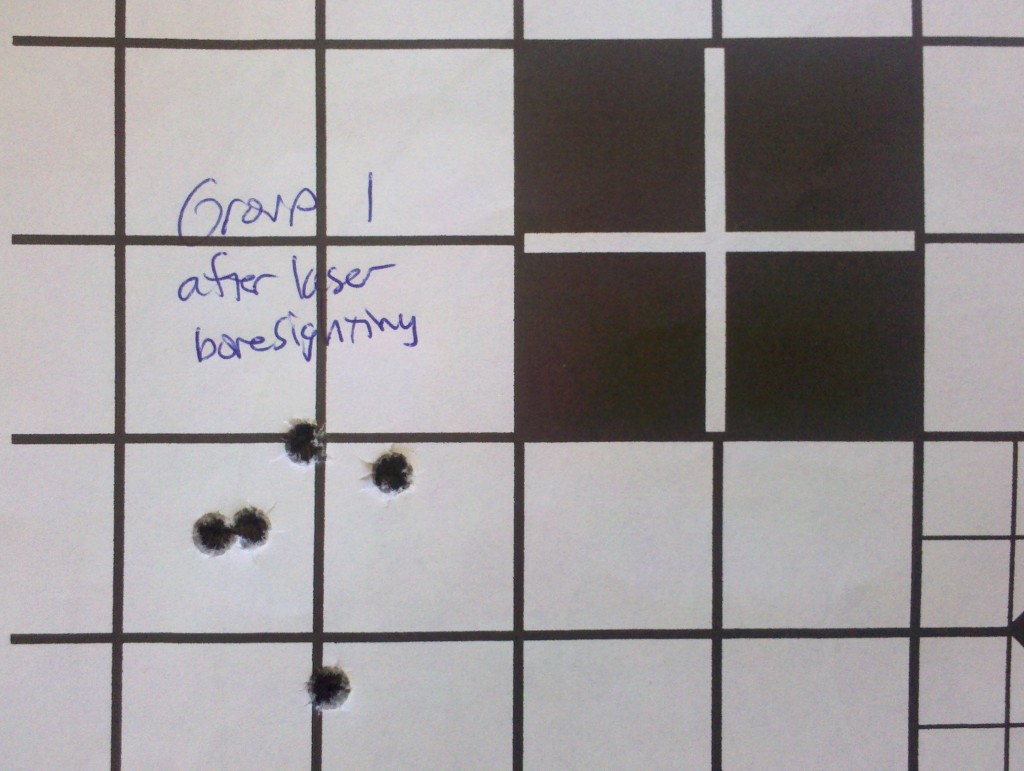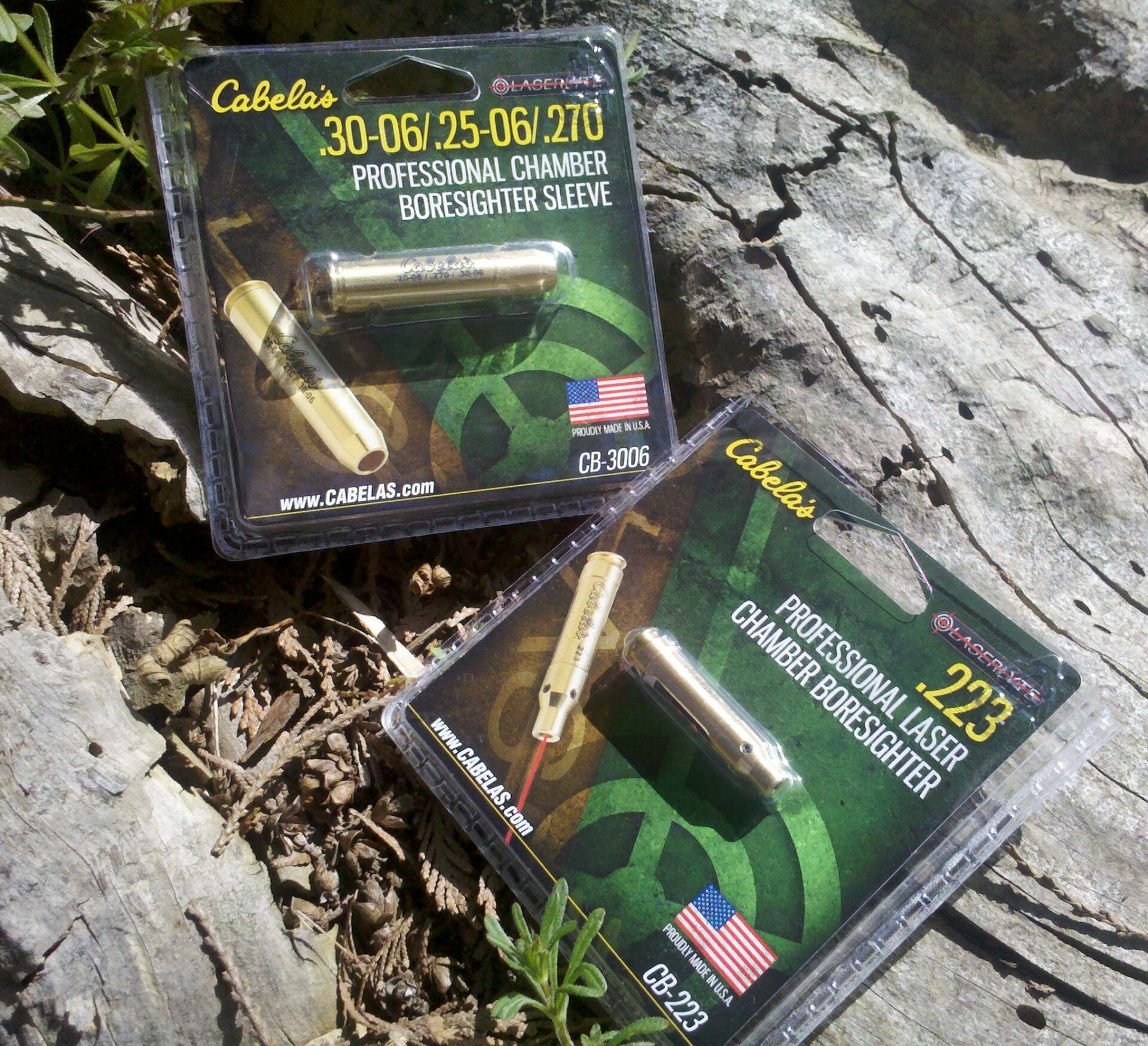 Time for a small confession: as much as I love to shoot, I’ve never really enjoyed sighting in new and untried rifles and scopes. I’m not very good at it, and I’ve sent an occasional shot downrange that missed my target completely and thumped harmlessly into the backstop. Or even landed on somebody else’s target. After a sheepish apology to the neighbor whose target I’ve spoiled, I have to guess how many full cranks of my errant scope’s adjustment dial it will take to put my shots on (my) paper.
Time for a small confession: as much as I love to shoot, I’ve never really enjoyed sighting in new and untried rifles and scopes. I’m not very good at it, and I’ve sent an occasional shot downrange that missed my target completely and thumped harmlessly into the backstop. Or even landed on somebody else’s target. After a sheepish apology to the neighbor whose target I’ve spoiled, I have to guess how many full cranks of my errant scope’s adjustment dial it will take to put my shots on (my) paper.
I’ve tried visually boresighting my rifles beforehand, but my skill at this art is so lacking that my C.E.P. (circular error probability) is still larger than my target stand at 25 yards. Basically, I’m so bad at boresighting that I need to start zeroing my rifles at a target distance of about ten feet. Then 25 yards (and more rounds fired) and 50 yards (more rounds) and then finally 100 yards. And more rounds fired. Lots more.
Until I joined the TTAG posse, having a new rifle or scope to play with was a fairly infrequent occurrence. The zeroing process may have been tedious, but the tedium was lost in the the excitement and novelty of getting to know my new gear. Since el jefe started burying me under a mountain of ARs, SCARs and scopes galore, however, this zeroing-in shit has gotten old fast.
 Enter Cabelas new Laserlyte Professional Laser Chamber Boresighter. As the name implies, it’s a chamber-mounted laser boresighter, and it’s machined in the shape of a .223 Remington case. The on-off switch protrudes from the back of the case where the primer would be, and it turns on when you close the breech of the rifle. As it shines down the barrel, it shows you where to center your aiming reticule. That’s the idea, anyway.
Enter Cabelas new Laserlyte Professional Laser Chamber Boresighter. As the name implies, it’s a chamber-mounted laser boresighter, and it’s machined in the shape of a .223 Remington case. The on-off switch protrudes from the back of the case where the primer would be, and it turns on when you close the breech of the rifle. As it shines down the barrel, it shows you where to center your aiming reticule. That’s the idea, anyway.
There are no detailed written instructions, just a bullet point on the back of the packaging that basically says (pardon the all-caps): INSERT LASER BORESIGHTER INTO CHAMBER.
Since not every rifle is a .223, Cabelas sells a wide range of machined brass sleeves ($20 to $25 each) to fit other rifle calibers. The .223 laser fits into the sleeves very snugly, so the .223 laser also comes with a small polymer ramrod for pushing it out of the sleeve. Don’t bother trying to remove it without the ramrod; it ain’t gonna happen.
Before using the boresighter to zero an untried scope, I used it in a rifle that was already zeroed. My Remington 700 ADL is chambered in .270 Winchester, and shoots exactly to my point of aim at 100 yards with my pet 140 grain handload.
With the .223 laser firmly inserted in the .270 sleeve (see the picture above) and chambered in my rifle, I peered through the scope at the longest indoor distance my house has: about 20 yards. The laser dot was precisely centered left-to-right, and about two inches below the crosshairs of my 4-16x40mm scope.
So far, so good. I took the boresighter out of the Remington so it wouldn’t drain the battery while I fiddled with my untried rifle/scope combination: a Ruger Mini-14 with an Ultimak scout scope rail and a Leupold 1-4x33mm scout scope. I wanted to adjust the Ruger’s scope until the red laser dot appeared in exactly the same place it did in the Remington’s scope at the same magnification.
So I put the boresighter back in the Remington for another look, but the laser dot had moved about two inches to the left of the crosshairs. I hadn’t adjusted the scope, the rifle, or the boresighter. As I grasped the bolt to remove the boresighter (but didn’t lift it), I noticed the laser dot moved again, a little closer to the vertical crosshair.
More experimenting showed that the laser dot moved about an inch at 20 yards when I wiggled the still-locked bolt handle. I’m pretty sure I don’t have a loose bolt or chamber; my 700 groups at about an inch at 100 yards when I do my part, and has occasionally rewarded me with sub-1″ groups at 300 yards. Such acceptable accuracy is not consistent with a loose action or an oversized chamber, so I’m pretty sure my Remington isn’t the problem.
In my .270, the laser dot strayed about 2″ at 20 yards depending on how I rotated the boresighter in the chamber of the Remington or how I put pressure on the bolt handle. This indicates that either the laser diode is not concentric to the axis of the machined brass housing, or the brass housing (or sleeve) does not properly fit the rifle chamber, or both.
I suspect that part of the problem lies with the multi-caliber sleeve and the dimensions of the .270 Winchester. The .25-06 and .270 Winchester are both based on the .30-06 case but the shoulder of the .270 is moved .001″ farther forward than that of the other two cases. Also, the case diameter at the shoulder of the .25-06 and .270 is .005″ larger than some (but not most) .30-06 specifications.
It’s a good bet that Laserlyte wanted to make sure the sleeve fit all .30-06 chambers, as well as all .25-06 and .270 Winchester chambers, and the resulting compromise is not quite a perfect fit in a .270 chamber.
If the laser diode itself is misaligned, the only remedy is to return it to the vendor for a replacement. Although there are four very small allen screws around the shoulder of the laser cartridge, the laser diode itself is not user-adjustable. The back of the package claims that the laser is “master aligned” and gave me no hint on how to adjust it myself, which is probably just as well.
How much of a practical problem does this misalignment create? The only way to find out was to boresight the Mini-14 (as best I could) and head to the range to see where it shot.
Using this boresighter is incredibly simple, and it only took about two minutes. I removed the .223 laser cartridge from the .270 sleeve (don’t lose that ramrod!) chambered it in the Mini-14 and closed the bolt, and adjusted the Leupold’s crosshairs until they pointed about 2″ above the laser dot at 20 yards.
But once again, the laser wasn’t aligned perfectly with the barrel. Just as it had done with the .270 sleeve, the .223 laser dot changed its apparent position (relative to the Leupold’s crosshairs) as the cartridge was rotated in the chamber. I didn’t have a practical way to cancel out this concentricity error, so just I quit rotating the laser cartridge and lined up the crosshairs above the laser dot. My preparations done, I loaded up my gear and headed to the range.
The shooting range was almost deserted, which gave me more time and less hassle as I experimented with the boresighter. I tried to use it at longer ranges than the 20 yards my house allowed, but it was impossible: under ideal shooting conditions (a perfect sunny day) the laser dot was invisible beyond about 20 feet, even in the shade. I was glad I’d already boresighted the Mini-14 indoors, because the laser just wasn’t bright enough for outdoor use.
 I shot a test target with the Ruger/Leupold at 25 yards, with the results above: holding on the dead center of the black squares, the point of impact was centered exactly 2″ left of my point of aim.
I shot a test target with the Ruger/Leupold at 25 yards, with the results above: holding on the dead center of the black squares, the point of impact was centered exactly 2″ left of my point of aim.
I know this isn’t a terribly tight group from a scoped rifle at 25 yards, but the test rifle is a 1980’s Mini-14, and they’re not renowned for their precision. It wouldn’t shoot tighter than one inch at 25 yards, but it was the only .223 I could borrow on rather short notice and one of the few rifles with a scout scope rail for testing the Leupold. The Leupold is betrothed to a different rifle (said to be on its way to my FFL guy as I write this) so I’ll save it for another post.
I’m not concerned that my test shots were low (bullets start to drop from the bore’s axis the instant they leave the muzzle) but I was hoping they would be more horizontally centered at such short range. Here’s the problem: at 100 yards, this group would hit eight inches left of my aiming point, and possibly not even on the paper.
Subsequent groups showed the same pattern: the laser dot pointed about 2″ right of the barrel’s axis at 25 yards. If the laser boresighter had been rotated differently in the chamber, it might have lined up better or it might have been worse.
Starting at 25 yards and firing five-shot groups before making any scope adjustments, it took me 25 rounds to zero the Mini-14 at 50 yards. This is much more efficient than my previous ‘aim-shoot-pray-adjust’ method of zeroing a rifle, with which I once wasted a whole box of ammo trying to get on paper at 25 yards. (Yes, that was embarrassing.) It’s also much more considerate of my neighbors on the firing line, whose targets I did not accidentally perforate, but it’s not what I was hoping for from this gear.
Before I packed up the Mini-14 and called it a day, I asked another shooter if he wouldn’t mind chambering the .223 laser and seeing where the laser dot lined up compared to his known point of impact. He chambered it in his STAG Arms left-handed AR-15 and (the shooting range was deserted except for us) covertly pointed it at the wall of a shed at the far end of the firing line. The result? The laser pointed two inches to the right of his actual point of impact as well, and it also moved when we removed the laser and re-chambered it.
Conclusion
It’s a definite improvement over not using a boresighter at all, but for $70 I think a laser boresighter should have a properly aligned laser, and for $20 I think the brass sleeves should fit more precisely than the .270 sleeve fit my rifle’s chamber. A look at the customer reviews on Cabelas.com tells me that my misaligned laser isn’t the only one to slip through QC.
And I understand that there’s only so much battery power (and thus only so much laser brightness) that you can squeeze into the compact dimensions of a .223 Remington case, but the laser’s poor outdoor visibility left me underwhelmed. If I hadn’t boresighted the Mini-14 inside my house, my trip to the range might have been wasted.
It will save you some ammo by putting you on paper with your first shot at 25 or 50 yards, but not at 100 yards. There’s a lot of competition in the laser boresighter market, and I expected better precision and visibility from a pricier model like this.
Ratings (out of five)
Convenience: *****
Pop it in the chamber and you’re ready to go, and there’s zero chance of blowing up your barrel.
Precision: **
Eight inches off-target at 100 yards? A misaligned laser diode and a sloppy .270 sleeve don’t do it any favors.
Visibility: ***
Just not bright enough for outdoor use except in deep shade, heavy overcast, or at dusk or dawn.
Overall Rating: **1/2





Thanks for the review. It was an intriguing idea (and I wanted to get one). But, I’ll pass now. Saved me some disappointment (and $70).
$70 is steep. I [over]paid about half that for the my Sight Mark with similar experience: The dot can move slightly each time you remove and re-chamber it.
But I can’t say I’ve had similar experience with my newer (S/N 581*) Mini-14. 🙂 More like 1″ groups @ 100 yd. on my better days.
Bore sights will save you a lot of ammo and headaches. Most go for about $30-40 though.
I have one of the cheapy ones that goes in the muzzle (unloaded, action open if possible, finger off the trigger) and it sounds like it works about as well as this with the added bonus of having almost any caliber.
I have a Bushnell laser boresighter that came with a variety of arbors from .17 to .50 calibers and cost about $30 bucks online. The arbors are plastic, easy to use and very unlikely to do any damage to a barrel. At 25 yards, when the beam was centered, my shots were 1″ low and 1″ right. That’s not good, but since it was a consistent variation it was very easy to compensate. I was able to zero my rifles in just a couple of shots. All in all, it’s a good tool for the price.
I’ve never had to use more than three shots – with no boresighting of any kind – to zero a scope on a rifle. You’re doing something seriously wrong.
I am; that’s why I’d hoped a product like this would help me!
This is the technique I use:
http://bulletin.accurateshooter.com/2010/01/super-simple-zeroing-procedure-gets-you-centered-in-4-shots/
The last time I tried it, my first shot was within 2moa of the the point of aim. Of course the was an F-class competition gun was sitting in a rest and rear sandbag.
However, even in an AR-15, I can do it within 5 shots or so. With an AR-15, the procedure is slightly modified… you have to take the upper off, and take out the bolt carrier group and charging handle, and then boresight the upper only. The hardest part is holding the upper in one place without the benefit of the lower while doing this — a second pair of hands and some regular sandbags helps.
I also bought a chamber-style laser boresighter back when I didn’t know any better, and had the same problem with visibility.
Same experience with another brand. Can’t see the red dot in daylight. Had to go back to fire-adjust-fire routine.
I tried their (Cabela’s) laser bore sight for my 9MM’s, as someone else stated, each time I removed and re-chambered the laser in the same gun, it would be on a different spot on the target. And it was the same on all three of my nines, so I took it back.
Same on my 7.08 rifle…… at 100mtrs the laser is 3ft to the left ! , work that one out !
Similar results – not good in any sunlight condition.
Poor value for the $$
Jim S
I bought the .223 and 3 of the sleeves while deployed to Iraq. I had all of the same problems mentioned above. If you really want to see how off they are, turn them on & lay them on the flattest surface you can find and roll it across the surface and watch the laser wobble on the wall. Mine were all over the place.
I don’t agree. Read that:
https://continueas.wordpress.com/tag/design/
Friendly, Martin
Comments are closed.